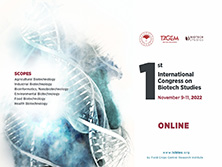Biotech Studies
2016, Vol 25, Num, 2 (Pages: 007-012)
Characterisation of Genetic Resources of Perennial Forage Grasses by Using Flow Cytometry
2 Namık Kemal Üniversitesi, Ziraat Fakültesi, Tarla Bitkileri Bölümü, Tekirdağ
3 Namık Kemal Üniversitesi, Fen Fakültesi, Biyoloji Bölümü, Tekirdağ
4 Doğu Anadolu Tarımsal Araştırma Enstitüsü Müdürlüğü, Erzurum DOI : 10.21566/tarbitderg.281591 - Taxonomic identification of perennial forage grasses is a difficult task due to their morphological similarities, ability to form interspecific hybrids by crossbreeding and natural variation. Additionally, polyploidy is very common in those species and there are individuals with different chromosome numbers within the same species. Therefore, it is necessary to identify plants taxonomically and determine their ploidy levels before using them in basic scientific research and plant breeding projects. Otherwise, the problems such as genetic incompatibility and sterility that may occur during the crossings can cause waste of limited resources of the researchers such as labour, time and money. In this study, nuclear DNA contents of 169 populations of the forage grasses (Festuca sp, Koeleria sp and Agropyron sp) collected from mountainous areas of Eastern Anatolia Region to use in breeding programmes were determined for the first time using flow cytometry and the information obtained from nuclear DNA content analysis was used to determine the ploidy levels and purity of the populations. According to the results of the study, ploidy levels of Festuca populations varied between diploid and octoploid (2n=14, 28, 42, and 56) while ploidy levels varied between diploid (2n=14) and tetraploid (2n=28) in Koeleria populations. In addition, some populations were not pure and included plants with different ploidy levels. All Agropyron populations analysed in the study were diploid (2n=14). All populations analysed in the study were taxonomically identified and named with the help of nuclear DNA analysis. Keywords : Festuca sp., Koeleria sp., Agropyron sp., flow cytometry, genetic resources















